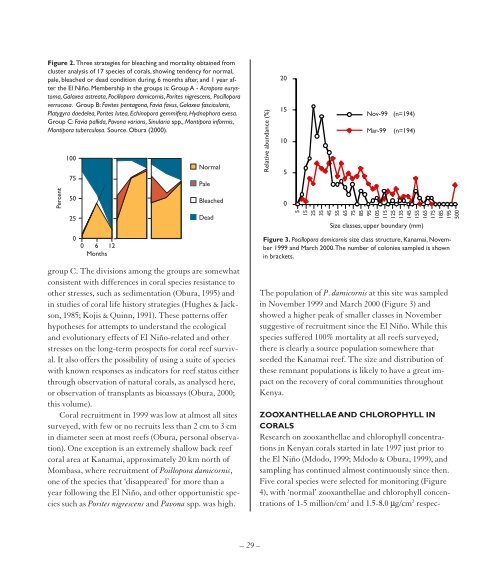You also want an ePaper? Increase the reach of your titles
YUMPU automatically turns print PDFs into web optimized ePapers that Google loves.
Figure 2. Three strategies for bleaching and mortality obtained from<br />
cluster analysis of 17 species of corals, showing tendency for normal,<br />
pale, bleached or dead condition during, 6 months after, and 1 year after<br />
the El Niño. Membership in the groups is: Group A - Acropora eurystoma,<br />
Galaxea astreata, Pocillopora damicornis, Porites nigrescens, Pocillopora<br />
verrucosa. Group B: Favites pentagona, Favia favus, Galaxea fascicularis,<br />
Platygyra daedelea, Porites lutea, Echinopora gemmifera, Hydnophora exesa.<br />
Group C: Favia pallida, Pavona varians, Sinularia spp., Montipora informis,<br />
Montipora tuberculosa. Source. Obura (<strong>2000</strong>).<br />
100<br />
75<br />
Normal<br />
Pale<br />
Relative abundance (%)<br />
20<br />
15<br />
10<br />
5<br />
Nov-99 (n=194) (n=194)<br />
Mar-99 Mar-00 (n=194) (n=251)<br />
Percent<br />
50<br />
Bleached<br />
0<br />
25<br />
0<br />
0 6 12<br />
Months<br />
Dead<br />
group C. The divisions among the groups are somewhat<br />
consistent with differences in coral species resistance to<br />
other stresses, such as sedimentation (Obura, 1995) and<br />
in studies of coral life history strategies (Hughes & Jackson,<br />
1985; Kojis & Quinn, 1991). These patterns offer<br />
hypotheses for attempts to understand the ecological<br />
and evolutionary effects of El Niño-related and other<br />
stresses on the long-term prospects for coral reef survival.<br />
It also offers the possibility of using a suite of species<br />
with known responses as indicators for reef status either<br />
through observation of natural corals, as analysed here,<br />
or observation of transplants as bioassays (Obura, <strong>2000</strong>;<br />
this volume).<br />
Coral recruitment in 1999 was low at almost all sites<br />
surveyed, with few or no recruits less than 2 cm to 3 cm<br />
in diameter seen at most reefs (Obura, personal observation).<br />
One exception is an extremely shallow back reef<br />
coral area at Kanamai, approximately 20 km north of<br />
Mombasa, where recruitment of Poillopora damicornis,<br />
one of the species that ‘disappeared’ for more than a<br />
year following the El Niño, and other opportunistic species<br />
such as Porites nigrescens and Pavona spp. was high.<br />
5<br />
15<br />
25<br />
35<br />
45<br />
55<br />
65<br />
75<br />
85<br />
95<br />
105<br />
115<br />
125<br />
135<br />
145<br />
155<br />
165<br />
175<br />
185<br />
195<br />
500<br />
Size classes, upper boundary (mm)<br />
Figure 3. Pocillopora damicornis size class structure, Kanamai, November<br />
1999 and March <strong>2000</strong>. The number of colonies sampled is shown<br />
in brackets.<br />
The population of P. damicornis at this site was sampled<br />
in November 1999 and March <strong>2000</strong> (Figure 3) and<br />
showed a higher peak of smaller classes in November<br />
suggestive of recruitment since the El Niño. While this<br />
species suffered 100% mortality at all reefs surveyed,<br />
there is clearly a source population somewhere that<br />
seeded the Kanamai reef. The size and distribution of<br />
these remnant populations is likely to have a great impact<br />
on the recovery of coral communities throughout<br />
Kenya.<br />
ZOOXANTHELLAE AND CHLOROPHYLL IN<br />
CORALS<br />
Research on zooxanthellae and chlorophyll concentrations<br />
in Kenyan corals started in late 1997 just prior to<br />
the El Niño (Mdodo, 1999; Mdodo & Obura, 1999), and<br />
sampling has continued almost continuously since then.<br />
Five coral species were selected for monitoring (Figure<br />
4), with ‘normal’ zooxanthellae and chlorophyll concentrations<br />
of 1-5 million/cm 2 and 1.5-8.0 µg/cm 2 respec-<br />
– 29 –


















